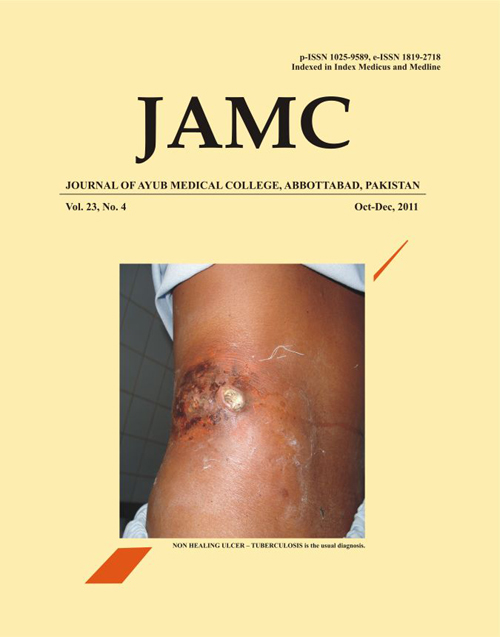PULMONARY EMBOLISM, THROMBOCYTOPENIA, AND ANTIPHOSPHOLIPID SYNDROME
Abstract
This case report describes a young non-smoker male masquerading under the diagnosis of communityacquired pneumonia who was found to have respiratory symptoms attributed to bilateral pulmonaryemboli. There was also evidence of thrombocytopenia and proximal deep venous thrombosis of rightlower limb. He underwent further investigations and was found to have positive anti-cardiolipinantibodies, lupus anticoagulant and prolonged activated partial thromboplastin time due to antiphospholipid antibody syndrome. This article highlights the importance of consideration of earlierdiagnosis in younger patients with congenital thrombophilias that carries potential for prevention andtreatment of life threatening thromboembolic manifestations.Keywords: Anti-phospholipid antibody syndrome, activated partial thromboplastin time, aPTT, deepvenous thrombosis, pulmonary embolism, thrombocytopeniaReferences
Miyakis S, Lockshin MD, Atsumi T, Branch DW, Brey
RL, Cervera R et al. International consensus statement on an
update of the classification criteria for definite antiphospholipid
syndrome (APS). J Thromb Haemost 2006;4:295–306.
Reber G, Tincani A, Sanmarco M, de Moerloose P, Boffa MC.
Proposals for the measurement of anti-beta2-glycoprotein I
antibodies. Standardization group of the European Forum on
Antiphospholipid Antibodies. J Thromb Haemost 2004;2:1860–2.
Galli M, Luciani D, Bertolini G, Barbui T. Lupus anticoagulants
are stronger risk factors for thrombosis than anticardiolipin
antibodies in the antiphospholipid syndrome: a systematic review
of the literature. Blood 2003;101:1827–32.
Dahlback B. Advances in understanding pathogenic mechanisms
of thrombophilic disorders. Blood 2008;112(1):19–27.
Crowther MA, Kelton JG. Congenital thrombophilic states
associated with venous thrombosis: a qualitative overview and
proposed classification system. Ann Intern Med 2003;138:128–34.
Pengo V, Ruffatti A, Legnani C, Gresele P, Barcellona D, Erba N
et al. Clinical course of high-risk patients diagnosed with
antiphospholipid syndrome. J Thromb Haemost 2010;8:237–42.
Bu C, Gao L, Xie W, Zhang J, He Y, Cai G et al. Beta 2-
glycoprotein is a cofactor for tissue plasminogen activatormediated plasminogen activation. Arthritis Rheum
;60(2):559–68.
Bobba RS, Johnson SR, Davis AM. A review of the Sapporo and
revised Sapporo criteria for the classification of antiphospholipid
syndrome. Where do the revised sapporo criteria add value? J
Rheumatol 2007;34:1522–7.
Schmugge M, Revel-Vilk S, Hiraki L, Rand ML, Blanchette VS,
Silverman ED. Thrombocytopenia and thromboembolism in
pediatric systemic lupus erythematosus. J Pediatr 2003;143:666–9.
Mosca M, Tani C, Bombardieri S. Undifferentiated connective
tissue diseases (UCTD): a new frontier for rheumatology. Best
Pract Res Clin Rheumatol 2007;21:1011–23.
Saadoun D, Piette JC, Wahl D, Costedoat-Chalumeau N.
Management of antiphospholipid syndrome. Rev Med Interne.
; 217–22.
Published
Issue
Section
License
Journal of Ayub Medical College, Abbottabad is an OPEN ACCESS JOURNAL which means that all content is FREELY available without charge to all users whether registered with the journal or not. The work published by J Ayub Med Coll Abbottabad is licensed and distributed under the creative commons License CC BY ND Attribution-NoDerivs. Material printed in this journal is OPEN to access, and are FREE for use in academic and research work with proper citation. J Ayub Med Coll Abbottabad accepts only original material for publication with the understanding that except for abstracts, no part of the data has been published or will be submitted for publication elsewhere before appearing in J Ayub Med Coll Abbottabad. The Editorial Board of J Ayub Med Coll Abbottabad makes every effort to ensure the accuracy and authenticity of material printed in J Ayub Med Coll Abbottabad. However, conclusions and statements expressed are views of the authors and do not reflect the opinion/policy of J Ayub Med Coll Abbottabad or the Editorial Board.
USERS are allowed to read, download, copy, distribute, print, search, or link to the full texts of the articles, or use them for any other lawful purpose, without asking prior permission from the publisher or the author. This is in accordance with the BOAI definition of open access.
AUTHORS retain the rights of free downloading/unlimited e-print of full text and sharing/disseminating the article without any restriction, by any means including twitter, scholarly collaboration networks such as ResearchGate, Academia.eu, and social media sites such as Twitter, LinkedIn, Google Scholar and any other professional or academic networking site.









